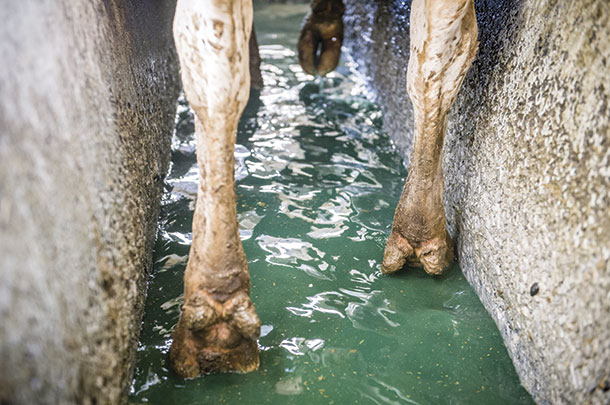A good hoof maintenance schedule is one of the most important contributors to a successful dairy operation. Foot health has a direct impact on milk production, and ignoring lameness in a herd can be far more costly than the price of a hoof health program.
Risk factors that can lead to lameness:
- Rough floor surface texture and long travel distance to the parlor add extra wear to hoof horn tissue, resulting in thin soles and abscess formation.
- Unsanitary conditions and overcrowding can lead to foot rot, hoof lesions, digital dermatitis or all of the above – especially common with animals found standing in manure for extended periods of time.
- Improper footbath protocol
Footbath protocols:

- Formaldehyde, copper sulfate with or without acidifiers and zinc are the most commonly used products in footbaths.
- Frequency of footbath use differs from farm to farm, but four days per week is widely accepted. Though for high lameness incidence rates, continual use may be necessary until the outbreak is under control.
- The pH level of the footbath impacts the effectiveness of the product used. When it’s too high, the chemicals in the footbath become inactive. It is generally recommended that the pH be between 1.5 and 4. This is often exceeded after roughly 200 cows pass through.
The use of pH test strips throughout the process can give an accurate assessment of how many cows can be treated.
Combating high copper prices:
- Copper is the world’s third-most widely used metal. While the market of this commodity is somewhat dependent on the health of the housing industry, copper pricing instability can lead to issues for producers who use the mineral as part of their farm’s hoof health protocol.
- Using a copper sulfate extender together with copper sulfate allows for animals to be treated more effectively for less money and may lower the inability for crop growth due to heavy metals on fields.
- Copper extenders don’t impact the way the copper sulfate is used, only how much is used. The frequency and method of the footbath protocol need not be altered to accommodate a copper extender.
- Copper sulfate and a copper extender are the best combination to treat hooves while maintaining consistency in pricing, but no matter what protocol your farm uses, being proactive with hoof health is a guaranteed return on investment.


Larry J. Judge
Professional Services Veterinarian
Animart
Email Larry J. Judge







